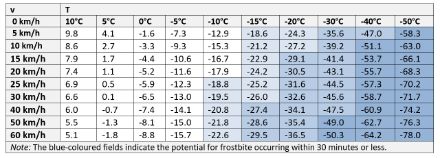Service Navigation
Search
Especially in the winter months, when low temperatures are combined with strong winds, we quickly feel the cold. In this context, we often talk about the wind chill effect. Wind chill is a meteorological measurement that describes the difference between the measured (objective) temperature and the perceived temperature (how cold it feels) because of the speed of the wind. The stronger the wind, the greater the cooling effect, and consequently the more quickly we feel the cold.
1. Perceived temperature
How cold or warm the air feels is not only dependent on the actual, measured, meteorologically “correct” temperature. There are other factors at play that influence how the temperature subjectively feels to humans (called “perceived temperature”). These factors include:
Meteorological factors:
- Humidity
- Wind speed
- Sunshine radiation conditions
Non-meteorological factors:
- Individual temperature perception: physical activity, clothing, body-heat production, body weight, body size, etc.
All of these factors combine with the air temperature to influence perceived temperature. In more humid or sunny conditions, for example, we perceive the temperature as higher, whereas in windy conditions, particularly in winter, we perceive it as colder. Perceived temperature cannot be measured, but it is a real parameter that helps us to determine the thermal stress on humans. It can be quantitatively defined as the temperature that would need to prevail in a standard environment in order to evoke an identical perception of warmth, comfort or cold in humans. Perceived temperature is a standardised meteorological parameter and is most commonly used in connection with heat warnings or for calculating the wind chill effect.
2. What is the wind chill effect?
The wind chill effect is often incorrectly equated with perceived temperature. Wind chill describes the sensation of cold and is therefore an element of the perceived temperature.
The wind chill effect describes the difference between the actual, measured temperature and how cold it feels, which is influenced by the cooling effect of the wind. As long as the air temperature is lower than our body temperature, a person will radiate heat. This means that the air around the skin warms up very slightly. We therefore have a warm layer of air on our skin’s surface that warms us up when temperatures are lower. When there is wind, however, this slightly warmer air is blown away. This speeds up the rate of evaporation from the skin. The body has to expend more energy for this, and there is a consequent loss of heat. The stronger the wind blows, the stronger this effect is and the more heat the body loses, thus making us feel cold.
In other words, the stronger the wind, the colder the same air temperature feels. This effect is called wind chill.
3. Quantification and calculation
The cooling effect on the skin caused by the wind can best be described in terms of temperature. This special temperature is called the “wind chill temperature” (WCT). The WCT is the air temperature that, in a standard environment (in shade and with slight air movement), would cause the same rate of heat loss per area of skin exposed to the wind as the actual air temperature would with the influence of the wind.
The definition of WCT was chosen for reasons of comprehensibility, as a temperature is better understood by the general public than a measurement in watts per square metre (in german), for example. It is therefore not a temperature in the true sense of the word, but a measure of the rate of heat loss that is simply expressed in units of temperature.
Important information
- Unlike perceived temperature (see above), the WCT does not take air humidity or radiation conditions into consideration.
- Moreover, it is only applicable to temperatures of 10 degrees or less – in other words, to temperatures lower than what we perceive as comfortable.
- WCT is also calculated on the basis of a number of assumptions that are not always true.
- For example, the altitude of the air is assumed to be at sea level. But in the mountains, the air is thinner, which means the heat loss and the wind chill effect are less.
- Additional influencing factors that affect how we perceive temperature (e.g. physical activity, clothing, body size and weight, etc.) are not taken into consideration.
Wind chill formula
WCT is calculated using the wind chill formula.
The table below contains several WCT calculations.


- The WCT gives a rough idea of how the measured temperature is perceived in combination with the wind.
- The WCT is not the temperature that a body assumes due to the wind.
- Rather, it expresses how much faster the temperature of the skin approaches the measured air temperature than it would if there were no wind.
- Wind chill temperature readings might be used by mountain climbers or skiers in high mountain areas (in german) for example, or by scientists in the polar regions (in german) as a guideline to better assess the risk of frostbite or hypothermia.
It is therefore not possible to provide generalised statements on wind chill (nor on perceived temperature), as it is always a subjective perception. The bottom line is that wind chill should be understood as an approximation intended to provide a rough guideline.